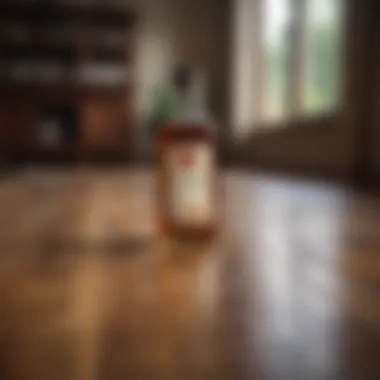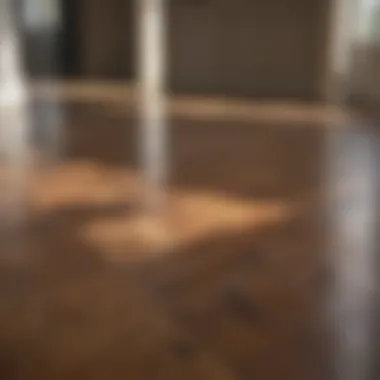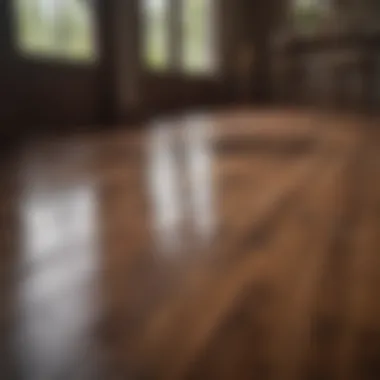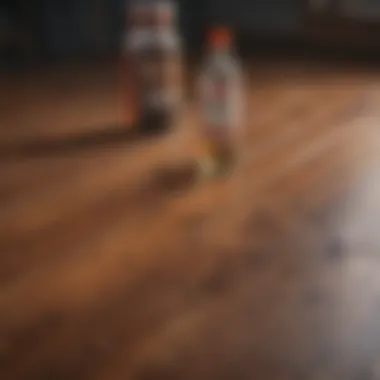Cleaning Wood Floors with Vinegar: An In-Depth Guide


Intro
Cleaning wood floors is more than just a routine chore; it’s a deeply enmeshed part of maintaining a home’s aesthetic and structural integrity. Considered by many as one of the most striking features in residential architecture, wood flooring adds warmth and character to any space. However, keeping those beautiful surfaces clean and unmarred isn’t as straightforward as it seems. Enter vinegar, a humble household staple that often occupies a spot in the kitchen but holds potential as an effective cleaning agent for wood floors.
The Relevance of Vinegar
In its simplest form, vinegar, particularly white vinegar, can be a powerhouse when it comes to cleaning. It’s an age-old remedy that has been championed for various cleaning tasks due to its acid content, primarily acetic acid, which helps cut through dirt and grime. But the question remains: is it suitable for wood floors? This article tackles that question head-on, alongside a range of considerations that homeowners may find beneficial.
From the environmental benefits of using vinegar over harsher chemical alternatives to its ability to effectively dissolve cloudiness and grime, the arguments in favor are compelling. Yet, there are also cautions worth noting regarding its use, particularly concerning the long-term health of wood surfaces. Each type of wood may react differently, and over time, improper use can lead to wear.
Addressing these issues ensures that not only is cleanliness achieved, but the life of the flooring is extended. This discussion is not just for the perpetually Pinterest-inspired or the Instagram interior design aficionado; it’s for anyone who cherishes the beauty of wood floors and seeks to prolong their charm. Armed with practical knowledge, homeowners can confidently wield vinegar as a cleaning tool—responsibly and effectively.
Prologue to Cleaning Wood Floors
When it comes to maintaining the beauty and functionality of wood floors, cleaning is as crucial as choosing the breed of wood in the first place. Wood floors are often the centerpiece of a room, calling for proper care to ensure they do not just look good, but also last long. In this context, understanding effective cleaning practices becomes imperative, particularly the use of vinegar—an age-old household item that oftentimes is considered the unsung hero of cleaning solutions.
Understanding Wood Floors
Wood floors, although aesthetically pleasing, come with their own set of challenges. Each type of wood, whether it be oak, maple, or cherry, not only varies in appearance but also in terms of density, durability, and maintenance needs. For example, softwoods like pine tend to scratch more easily and may require different cleaning solutions compared to hardwoods like mahogany. It's important for homeowners to familiarise themselves with the specific wood they have underfoot.
Moreover, wooden floors have finishes that should be nurtured. Common finishes like polyurethane or lacquer offer protection but can be sensitive to certain chemicals, making the specifics of the cleaning method all the more important. A routine that incorporates the right cleaning solutions tailored to the floor's finish can make a noticeable difference in the longevity and appearance of the wood. In the case of vinegar, its natural acidity poses both benefits and risks, thus warranting a keen understanding of this household staple.
The Importance of Proper Cleaning
Cleaning wood floors is often seen as a mundane task, yet it carries significant weight in protecting one’s investment. Over time, dirt, dust, and grime can accumulate, dulling the floor’s shine and potentially leading to scratches. Not only does a proper cleaning routine enhance the floor’s appearance, but it also promotes a healthier living environment.
Using the right product—like vinegar—can efficiently tackle regular dirt. However, one must be ever so careful, as improper cleaning methods can strip finishes and leave floors looking worse for wear. Emphasizing proper cleaning techniques minimizes the need for costly refinishing processes down the line, ensuring that the floors stay not just clean, but in tip-top shape for years to come.
"The key to the longevity of wood floors lies in consistent, mindful cleaning."
The Chemistry Behind Vinegar
Understanding the chemical foundation of vinegar is vital for anyone looking to clean wood floors effectively. Many people assume that the cleaning power of vinegar comes from sheer force, but it’s a combination of its unique acidic nature and its ability to break down grime and stains. This section will detail what vinegar is made of and how it interacts with the surfaces of your beautifully finished wood floors.
What is Vinegar?
Vinegar is far more than just a common household condiment. At its core, vinegar is a dilute solution of acetic acid in water. The typical concentration of acetic acid in household vinegar ranges between 4% to 7%. This acidic component is responsible for vinegar’s distinctive tang and also contributes to its cleaning properties.
Vinegar can be derived from various sources, including:
- Wine: Produces wine vinegar.
- Apples: Leads to apple cider vinegar, which many swear by for its health benefits.
- Cereal Grains: These can be fermented to create malt vinegar.
The fermentation process transforms sugars into alcohol and then further into acetic acid, resulting in a product that’s both versatile and effective for cleaning tasks and culinary uses alike. The presence of acetic acid is what sets vinegar apart as a natural cleaning solution.
How Vinegar Interacts with Surfaces


When it comes to cleaning, understanding how vinegar interacts with different surfaces is fundamental. Wood floors, while sturdy and long-lasting, have their own sensitivities, particularly due to the natural grains and finishes applied to them.
- Dissolution of Mineral Deposits: The acid in vinegar can help dissolve mineral buildup, such as hard water stains on wooden floors. This can be especially beneficial in areas like kitchens or bathrooms where water exposure is common.
- Breaking Down Organic Matter: Vinegar effectively breaks down organic dirt and grease. Thus, using a vinegar solution can help lift food spills, grease marks, and other residues without harsh chemicals that can wear down the wood’s finish over time.
- Reaction with Finish: However, it’s essential to consider how vinegar interacts with the finish applied to wood floors. If the finish is water-based, vinegar might not pose as great a risk of damage. Oil-based finishes, on the other hand, could react negatively due to the acidity, potentially corroding the finish and leading to dullness.
- pH Level Consideration: Wood is sensitive to pH levels. Vinegar has a pH level of around 2 to 3, which is significantly lower than neutral (pH 7). This acidity is handy for cleaning but can strip the protective coating on your wood floors if used excessively.
"A little vinegar goes a long way. Knowing how to use it correctly can help maintain the beauty of your wood floors without breaking the bank."
In summary, the chemistry of vinegar plays a crucial role in its effectiveness as a cleaner. Its unique composition and the way it interacts with different materials make it a popular choice for home cleaning regimens. However, caution is required, especially regarding the finishes on wood floors. Knowing these details can make a world of difference in upkeep and maintenance.
Benefits of Using Vinegar on Wood Floors
Cleaning wood floors can be a tricky endeavor. Many homeowners find themselves wrestling with a myriad of choices when it comes to selecting the right cleaning agent. Vinegar emerges as a viable option for cleaning wood floors primarily due to three significant benefits: its natural cleaning properties, cost-effectiveness, and environmental considerations. Understanding each of these aspects allows homeowners to make informed decisions regarding their cleaning routines, ultimately ensuring the preservation of their cherished wood floors.
Natural Cleaning Properties
Vinegar has long been praised for its powerful cleaning prowess. The acetic acid in vinegar works wonders on dirt, grime, and even some stubborn stains. When diluted with water, it becomes a gentle yet effective solution that can lift away daily messes without sacrificing the integrity of the wood. Many people prefer it to commercial cleaners that may contain harsh chemicals, as these can wear down the finish of the wood over time.
Vinegar can also neutralize odors, leaving a fresh scent in the home. A simple mixture—one part vinegar to four parts water—creates a solution, ready to tackle spills in the kitchen or muddied footprints in the living room. Following this method, users can maintain appearance and cleanliness without resorting to chemical-laden products. This natural alternative is not only effective but also aligns with many homeowners’ desires for more organic cleaning methods.
Cost-Effectiveness
One undeniable perk of using vinegar for cleaning is its cost-effectiveness. A bottle of white vinegar is relatively inexpensive, costing mere cents per use compared to commercial wood floor cleaners, which can be quite pricey. With the prices of household items constantly on the rise, using vinegar can help keep cleaning budgets in check.
Furthermore, because vinegar is so versatile, it can serve multiple functions beyond just cleaning wood floors. It can be utilized in the laundry, as a fabric softener, and even in cooking—making it a multi-purpose staple in many homes. Buying a single household product that handles various tasks simplifies shopping and storage, saving both time and money.
Environmental Considerations
In today's eco-conscious world, many individuals strive to make choices that benefit both their health and the environment. Opting for vinegar as a cleaning solution is a step in the right direction. The ingredients found in grocery store cleaners often pose potential risks to the environment, from harmful runoff entering the water system to the packaging that adds to landfill waste.
Using vinegar sidesteps many of these issues. As a biodegradable product, it poses little risk to local wildlife or ecosystems. Moreover, employing a diluted vinegar solution can minimize the number of plastic bottles used and discarded for cleaning products. Thus, adopting vinegar in one's cleaning routine aligns closely with sustainable living practices and showcases a commitment to reducing one's carbon footprint.
"Vinegar isn’t just an option; it’s a powerful ally in the quest for clean and eco-friendly homes."
By understanding and considering the advantages of using vinegar for wood floor maintenance, homeowners can confidently incorporate this method into their routine, ensuring that their wooden surfaces remain looking great while also being kind to the wallet and the planet.
Potential Risks of Using Vinegar on Wood Floors
Using vinegar to clean wood floors comes with its share of potential risks. While numerous articles praise its natural cleaning properties, a homeowner must also consider the downside. Understanding the risks of vinegar is vital to preserving the condition of wood flooring and ensuring that cleaning efforts yield the desired results without causing harm.
Acidity and its Effects
Vinegar’s primary component is acetic acid, which can effectively dissolve dirt and grime. However, what makes it powerful as a cleaner can also lead to issues when it comes in contact with wood surfaces. The acidity can erode the finish of the wood over time. This degradation often goes unnoticed initially but gradually exposes the wood beneath. The following points outline the effects vinegar may have on wood due to its acidic nature:
- Dulling the finish: Regular use of vinegar can cause the glossy sheen on wood floors to lose its luster, making them appear dull and worn.
- Penetration of moisture: When the finish is compromised, vinegar can seep into the wood’s surface, potentially causing swelling or warping.
- Increased maintenance needs: As the finish wears away, homeowners might find themselves having to refinish or recoat their floors more frequently, leading to added expense and labor.
Moreover, homeowners should always test vinegar on a small, inconspicuous area first. This trial run can help gauge whether vinegar could cause any adverse reactions on the specific wood type or finish used.
Possible Damage to Finish
The finish of wood floors acts as a second skin, protecting the wood from scratches, moisture, and daily wear and tear. Vinegar has the potential to compromise this critical layer. Here’s how vinegar can damage finishes:


- Polyurethane finishes: Commonly used for wood floors, polyurethane creates a protective barrier. Though resistant, it can still be affected by the acidity of vinegar, leading to bubbling or peeling of the finish.
- Oil-based finishes: Using vinegar on oil-finished wood can also be detrimental. The acidity can break down the oil sealant, leading to an uneven appearance.
- Hardwood vs. softwood: Different types of wood may react differently to vinegar. For example, softer woods like pine might experience more significant damage than hardwoods like oak or maple due to the way they absorb moisture.
Alternatives to Vinegar for Cleaning Wood Floors
When it comes to cleaning wood floors, understanding your options is as vital as knowing how to wield a mop. While vinegar has its staunch supporters, it’s not the only game in town. This section aims to shed light on some viable alternatives that can effectively maintain the beauty and integrity of your wood floors.
Commercial Wood Floor Cleaners
Every homeowner knows the allure of a shiny floor, and the market offers a plethora of commercial cleaners specifically designed for wood surfaces.
- Purpose-Built Formulas: These cleaners often contain ingredients tailored to clean without damaging finishes. They are developed with the unique qualities of different wood types in mind, making them a reliable choice.
- Ease of Use: Most commercial cleaners are straightforward to use. Just spray and wipe or follow specific instructions on the label. No guesswork required.
- Quick Action: The formulations often penetrate dirt and grime, providing a quicker cleaning experience. It’s like having a secret weapon in your cleaning arsenal.
However, it's crucial to choose wisely. Not all brands boast a good reputation. Look for products that are free from harsh chemicals and those that emphasize eco-friendliness. Reviews from fellow wood floor aficionados can provide insight too.
Homemade Cleaning Solutions
If you lean towards DIY, several homemade cleaning solutions can give your wood floors a new lease on life.
- Basic Mixture: A simple concoction of warm water and mild dish soap, mixed together in a bucket, offers a practical choice for light cleaning. Just keep it damp, as too much water can warp wood.
- Oil and Vinegar Blend: If you're a fan of the vinegar but want a gentler approach, consider mixing equal parts of olive oil and vinegar. This not only cleans but also adds a touch of shine to your floors.
- Tea Infusion: Brewing a few tea bags in hot water and using the cooled mixture can work wonders. The tannins in tea can help enhance the wood’s natural hue.
Using homemade solutions can save you a few bucks, and there's a certain satisfaction in creating your own cleaning products. Just remember to always spot test any solution to ensure it won’t affect your floor's finish.
Ultimately, whether you opt for commercial cleaners or roll up your sleeves for some homemade alternatives, the right approach ensures your wood floors remain a stunning centerpiece in your home.
"Choosing the right cleaning method is about finding a balance between effectiveness and safety for your cherished wood floors."
Keep exploring different options, etch them into your cleaning routine, and watch your wood floors thrive as they bask in attention and care.
Best Practices for Cleaning Wood Floors
Cleaning wood floors can be a delicate task, especially when considering the longevity of the material. When using vinegar as a cleaning agent, adhering to the best practices can make a world of difference. Understanding these principles will not only ensure a sparkly finish but also avoid any mishaps that could lead to damage. It’s more than just cleanliness; it’s about maintaining the natural beauty of wood floors while keeping them in top shape.
Preparation Before Cleaning
Before diving into the cleaning process, preparation is key. Here are steps you should take:
- Gather Your Supplies: Ensure you have white vinegar, a bucket, warm water, and a soft mop or cloth. Avoid any abrasive tools that could scratch the wood.
- Clear the Area: Remove furniture, rugs, or any items that could hinder your cleaning. This also helps prevent any potential spills or accidents when moving heavy objects.
- Sweep or Vacuum: A thorough sweep or vacuum prevents dirt and dust from scratching the floor’s surface during cleaning. It’s important to pick up all loose debris before applying any cleaner.
- Test a Small Area: Apply your vinegar solution to a hidden corner first. This ensures there are no adverse reactions with your specific floor finish.
These steps set the stage for an effective cleaning experience. By preparing thoroughly, you minimize risks and enhance the efficiency of your cleaning routine.
Technique for Using Vinegar
Using vinegar requires a little finesse to optimize results. Here’s a practical approach you can follow:
- Mixing the Solution: Combine one cup of white vinegar with a gallon of warm water. This dilution cuts down the acidity while maintaining cleaning effectiveness.
- Mopping Method: Dip your mop into the solution and wring it out until it’s barely damp. Excess water can seep between floorboards, potentially causing damage. A damp mop is essential for wood floors.
- Mop in Sections: Work systematically in small sections. While you mop, take care to go with the grain of the wood. This method helps lift dirt without leaving streaks.
- Drying: After mopping each section, follow up with a clean, dry cloth to remove any remaining moisture. This quick action helps eliminate potential water damage.


Employing these techniques ensures that you’re getting the most out of your vinegar cleaning without risking harm to your floors.
Frequency of Cleaning
Establishing a regular cleaning schedule bolsters the care of your wood floors. Here’s a loose guideline:
- Daily: Sweep or vacuum to keep dirt at bay.
- Weekly: Use the vinegar solution for a thorough clean. This frequency helps maintain wood’s luster and keeps buildup from forming.
- Monthly: Consider a deep clean, possibly re-evaluating your finish and applying a maintenance product, as needed.
- Seasonally: Inspect floors for scratches or damage, and touch up any worn areas to keep the integrity of the wood intact.
Aligning cleaning frequency with specific needs helps assure that your wood floors remain in prime condition for years to come.
"Neglecting wood floors is akin to putting off health check-ups; regular upkeep makes a world of difference."
By employing these best practices, you create a roadmap for maintaining not only a pristine appearance but also the structural health of your wood floors.
Long-Term Care for Wood Floors
Taking care of wood floors isn't just a once-in-a-blue-moon affair. Long-term care is crucial in extending the life of these beautiful surfaces. Proper maintenance will not only preserve the wood but also keep it looking as inviting as the day it was installed. When homeowners prioritize ongoing care, they can fend off unnecessary expenses associated with repairs and refinishing.
The benefits of consistent maintenance are manifold. For one, it enhances the aesthetic appeal, giving the flooring a lustrous finish. Beyond looks, regular cleaning and upkeep help maintain the structural integrity of the planks, preventing issues such as warping or buckling due to moisture exposure. People often forget that wood is sensitive to its environment. Hence, a steady routine in care can mitigate damage caused by fluctuating humidity and temperature.
Regular Maintenance Strategies
Regular maintenance strategies include both daily and weekly tasks that help ensure wood floors remain in pristine condition. Here are some effective strategies:
- Sweeping or Vacuuming: The most basic step is to keep dust, dirt, and debris at bay. Regularly sweeping or vacuuming keeps particles from scratching the surface.
- Damp Mopping: Rather than soaking the floor, a damp mop can pick up deeper dirt without causing moisture damage. Use a mixture of water and vinegar diluted to a safe ratio for deeper cleaning.
- Using Protective Mats: Placing rugs or mats in high-traffic areas can deflect some wear and tear. These small additions can protect your investment significantly.
- Avoiding Harsh Chemicals: Stick to pH-neutral cleaners. Using harsh chemicals can dull the finish over time.
- Rearranging Furniture: Regularly changing the layout can reduce uneven wear in spots, ensuring the floor's surface ages uniformly.
Identifying Signs of Damage
Keeping an eye out for signs of damage is just as vital as maintenance routines. Early identification can mean the difference between a simple repair and an extensive overhaul. Here are a few signs to watch:
- Scratches or Scuffs: Look for surface scratches that could deepen if left untreated. Some might be able to buff out with an appropriate cleaner or polish, while others might necessitate more extensive repair.
- Discoloration: Fading or stains might indicate moisture penetration or improper cleaning methods. Whenever you see discoloration, take a closer look to locate potential sources.
- Cupping or Crowning: If you notice the edges of the boards appearing higher or lower than the center, it’s a call for alarm. These issues can be initiated by moisture problems and need to be assessed quickly.
- Squeaky or Loose Boards: Hearing a noise when walking is often a sign of boards not being correctly fastened or moisture-related expansion and contraction.
"Regular inspection and timely care can save significant money in repairs and keep wood floors both functional and beautiful for decades."
By engaging in these practices, homeowners will fortify the longevity of their beautiful wood floors, ensuring that their investment remains as stunning as it was on the day of installation. The relationship we have with our homes and their interiors thrives on attention and care; wood floors are no exception.
End
When it comes to cleaning wood floors, the topic of using vinegar is one that certainly warrants thorough discussion. This article has delved into the multifaceted aspects of vinegar as a cleaning agent, shedding light on its chemistry, advantages, and potential pitfalls.
Summary of Key Points
To recap, vinegar is a natural, cost-effective cleaner that can help maintain the sheen of your wood floors. Its acidic properties can break down grime and provide a fresh scent. However, it’s crucial to remember that too much acidity can lead to damage, particularly to the floor’s finish. Here are the quintessential points:
- Natural Cleaning Agent: Vinegar is a non-toxic alternative to commercial cleaners, which often contain harsh chemicals.
- Cost-Effectiveness: It is inexpensive and widely available, making it an accessible choice for many homeowners.
- Environmental Considerations: Being a biodegradable substance, vinegar is kinder to the planet than many commercial products.
- Potential Risks: Care must be taken. Overuse may strip the finish or leave behind residues.
- Alternatives: There are effective alternatives available for cleaning wood floors if vinegar presents too much risk in some cases.
Final Thoughts on Vinegar Use
Ultimately, using vinegar to clean wood floors is both an art and a science. While it holds potential for excellent results in keeping wood floors looking their best, caution is essential. Homeowners should pay heed to the specific type of flooring, as some finishes may react differently to vinegar.
Moreover, periodic assessment of the floor's condition is key. If signs of wear and tear appear, it may be prudent to glance toward alternative cleaning methods or consult a flooring professional. The pro-active approach can save time and potential headaches down the line.
In the realm of interior aesthetics, a well-maintained wood floor can elevate the entire ambiance of your home, making it vital to choose the right cleaning strategy and material. As long as you are informed and cautious about your choices, vinegar can be a valuable tool for achieving impeccable wood floors.







